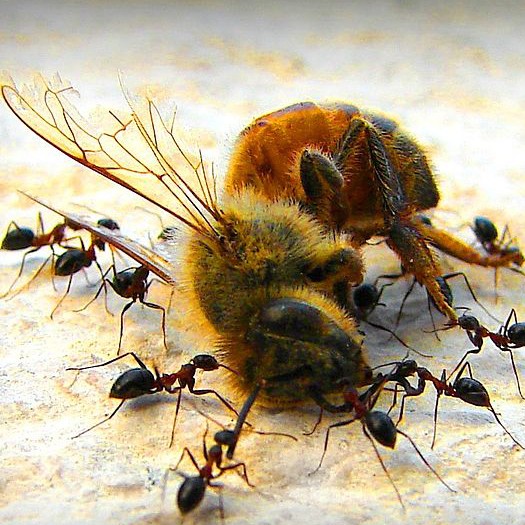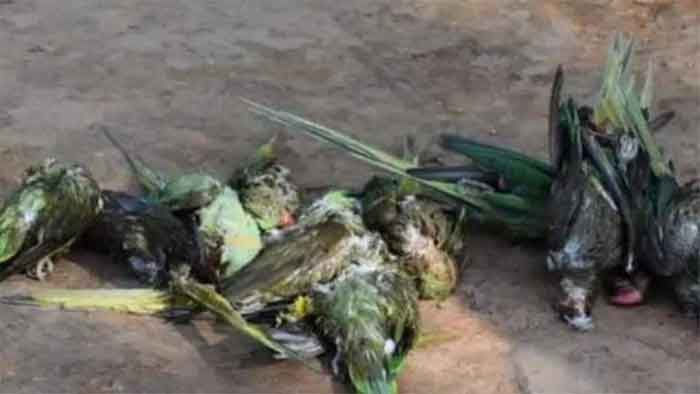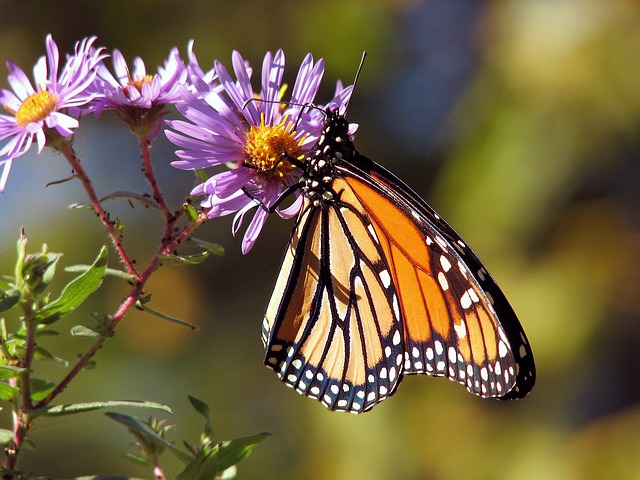by Thomas Klikauer and Meg Young

Our world is rapidly moving towards the rather inevitable global insect apocalypse unless we stop the three enemies that got earth into a life-threatening trouble: a) the destruction of the natural habitat of insects – the concreting of nature; b) Big-Agro-Business’ rampant Über-use of insecticides and other deadly chemicals, i.e. no more chemical warfare on nature; and finally, c) stopping global warming in the hope of avoiding the creation of The Uninhabitable Earth.
The hammering and eventual destruction of insects through these three forces will unleash an environmental Armageddon unseen by humanity. This form of a mass killing of insects might be something like an insect-o-cide. Wherein, Insect-o-cide merges the word “insect” with the Latin suffix “cide” (to kill), to create: insectocide.
If one assumes that all human beings were to vanish from earth, their absence would hardly be registered by nature – apart from those domesticated animals we keep in industrial farming, – in cages, prisons, and worse.
What is looming is the Anthropocene or better yet, an Eremocene – the Age of Loneliness – before we die. Precursors to much of this are little facts like the research done in the year 2018. It found that more than a third of birds have vanished from French farmlands in just over three decades.
At some point, such a countryside can become a desert. It’s the same story all over the world: as soon as an industrial-scale Agro-Business moves in, it follows the same corporate-driven rules of agro-capitalism that is driving us towards the Capitalocene.
Ten years before that, from the French research in 2008, we already saw a vicious year for European honeybees. Millions perished in France, the Netherlands, and Italy. Whilst the loss was at the deepest in Germany. Barely a decade later in Brazil, half a billion bees perished in just a few months. Their dead bodies riddled with something called Fipronil – which is a chemical insect killer banned by the European Union.
Worse, during past quarter of a century, Big-Agro in the USA has assured that the environment has become 48-times more toxic to insect life. As a consequence, insects are being systematically mutilated, flummoxed, and ultimately: annihilated.
Even unhealthier is the fact that the so-called American heartland (Iowa, Illinois, Indiana, Missouri, and parts of five other states) has become an unbelievable 121-times more toxic for bees over the past twenty years.
To camouflage all this, Big-Agro follows the well-proven propaganda strategies already applied by Big-Tobacco, Big-Oil, Big-Sugar, etc. Just as in previous decades, pesticide manufacturers too, have funded special propaganda groups – PR experts call it: astroturfing. They are set up and financed to dispute research findings telling us that toxic chemicals are not too harmful; they even bought and co-opted the once critical scientists; and they backed inconsequential bee-supporting initiatives that sustain agro-business.
Almost self-evidently – Monsanto, which is owned by Germany’s agro-corporation Bayer – endeavored to organize a PR campaign to discredit scientists who linked Roundup to cancer. And they have a good reason to smokescreen the toxicity of their products.
In fact, in 2018, the five biggest pesticide manufacturers sold $4.8bn – $4,800,000,000 worth of highly hazardous pesticides – equal to the value of roughly 12,000 houses.
Yet, big corporations are not always successful. In the same year, the European Union opted to ban all outdoor uses of toxic chemicals, such as clothianidin, imidacloprid, and thiamethoxam. They are the three most common neonicotinoids – a class of neuro-active insecticides, chemically similar to nicotine. Banning bee-destroying chemicals was one of the first major regulatory response to the insect-o-cide.
More recently, Austria, the Czech Republic, Italy, and the Netherlands have restricted the use of the weed killer glyphosate. Even in the place that owns Roundup (i.e. Germany), there are plans to follow that move by 2023.
Much of this isn’t new. The world once won over DDT. Given our natural characteristics and the public relations’ power of corporate media, it is not surprising to see that we keep making the same mistakes over and over again: not banning harmful chemicals.
Yet, we also make other mistakes. We have been made to believe that lawns around our houses are petit-bourgeois must-haves ornamenting our middle-class suburban lifestyles with virtually the same “aesthetic” uniformity of our houses. These lawns radiate – mostly to neighbors under the idea of Keeping up With the Joneses! – that there needs to be a crypto-lush green that is weed-free and neatly manicured to death. Trimmed into an insect death zone, they are the perverted versions of our indoor plastic carpeting.
In the USA alone, a gigantic $36bn insect destruction industry supplies herbicides and mowers to keep lawns in a repellent state of Dante’s insect inferno. Such turfs are soaked in 26.5 billion liters of water each day. Worse, they are also bombarded with 27 million kilograms of pesticides each year. It is a chemical warfare of the worse kind administered onto unsuspecting insects.
Even NASA saw the madness when its satellites discovered that lawns – and this includes commercialized lawns such as golf courses – are the largest irrigated plantations in the USA stretching over a whopping 128,000 square kilometers – three times the land used to grow corn on.
Largely engineered by TV ads, adjacent TV shows, and lifestyle-shaping movies, we have been made to believe that lawn clipping and pulling weeds out is normal. Yet, it is a part of an obsession with petit-bourgeois’ order and neatness. Interestingly, we personally like to help tigers, polar bears, whales, elephants, rhinos and the like. Simultaneously, we engage in chemical warfare against insects and bees in our gardens – the madness of what we call: civilization.
While we calm our middle-class feelings with generous donations, global warming’s toll on insects is not only set to grow, it is also massive in its global consequences. Even under the utmost optimistic developments, within just 50 years, 1.2bn people will live in temperatures currently found only in the most roasting areas of Africa’s Sahara.
With global warming, we will never be the only species suffering from a catastrophe engineered by an industry pumping huge volumes of planet-warming gases into earth’s atmosphere. Global warming will trigger huge waves of mass-deaths all across the animal kingdom.
Today’s computer models already project global warming of 1.5°C to 3.2°C – and above. Cranking up global temperatures faster means that not just animals will struggle to survive. Worse, at 3.2°C of global warming – which the world is on track to have by the end of the century – about half of all insect species will lose more than half of their current habitable areas.
Worse, beyond an increase of 3°C, enormous areas of land will become unsuitable for many crops. At 4°C, there would be a spiraling risk of famine, particularly in countries that cannot afford substantial imports of food from overseas. Mass death will follow. Inevitably, it will not be a pretty picture.
At that point, some might realize that we have the military apparatus to kill each other many times over, but we might no longer have the power to save each other. Years before that, this will have happened:
The talismanic Joshua trees, found only in the Mojave Desert of the southwestern United States, are wholly reliant upon an unglamorous gray insect, the yucca moth, for its pollination, a relationship described by Charles Darwin as, the most wonderful case of fertilization. The Joshua trees, with their crooked limbs and clubbed tufts, are a regular scenic backdrop in movies and TV shows, but rising temperatures and prolonged droughts are narrowing their habitat. They may all be gone by the end of the century.
On a much milder scale, we are likely to see this: in spring, bees take signal to emerge from hibernation from temperature. Meanwhile, many plants take signals to flower from the length of a spring day. Global warming causes a mismatch as springs and winters get hotter and hotter. Put simply, some things are warming up too early. As a consequence, bees are coming out early, but not too many flowers are there because the day’s length is not changing.
Beyond that, a much hotter world will also deliver a range of insect pests and pathogens to many countries that didn’t have them previously. They will attack potatoes, soybeans, wheat, and other crops. To a large extent, the world runs on just three kinds of grains: wheat, rice, and corn. These three will be stripped by predators. Worse, mono-cultural farming practices will help the process of grain destruction along.
Meanwhile, human beings will have to fight with an expansion of new and more mosquitoes. These will carry ever more lethal diseases such as dengue, chikungunya, and feared Zika virus. Inevitably, they have already started to spread from the tropics. Global warming is making living in Northern areas ever easier for them. This brings another one billion people into the range of deadly mosquito- borne diseases.
Freezing temperatures that used to kill mosquito eggs during winter will no longer occur. Global warming will allow such insects to infiltrate and eventually to dominate entirely new territories. This has already triggered outbreaks of dengue in France and Croatia, chikungunya in Italy, and malaria in Greece in the past decade.
Yet, with the invasion of heat-loving mosquitos, an entirely new insect will also arrive: the Asian giant hornet or killer hornet. The thumb-sized hornet is a super villain. It has a tiger-striped abdomen and a large orange colored face. Despite not being particularly dangerous to human beings, however they kill honeybees.
Killer hornets hang around beehives hideously attacking bees. They start by decapitating worker bees. Then, they dismember their victims, to be followed by feeding dead bee body parts to their larvae. This massacre can continue until a functioning beehive is completely exterminated. What remains are thousands of scattered bee corpses – a truly apocalyptic picture.
Beyond all that, there still is a slight chance to get stung by the killer hornet. Get this a few dozen times and there’s a real chance people will die. It was a fate suffered by dozens of people in Japan and China. As global warming moves in, killer hornets will come too. And, unlike our common honey bees, Asian giant killer hornets can sting multiple times. And worse, they can deliver ten times the venom.
Next to the destruction of the natural habitat of bees and Big-Agro’s insecticides, global warming will also bring parasitic mites and poor nutrition to bees, diminishing the strength of beehives. This renders them incapable to fight what attacks them.
When honey bees are hit by a combinations of these – toxic chemicals, habitat destruction, and global warming – the outcome can weaken and eventually overcome a honeybee colony’s ability to survive. While honeybees may have been around for about 200 million years, what we put in their way, may destroy them.
Unlike honey bees, scientists know less about wild bees. Yet, an assessment of 2,000 wild bee species in Europe in 2015 found that one in ten species are at risk of extinction. Meanwhile in the USA, fourteen bee species in the Eastern New England states have declined by as much as 90% over the past century.
Back in Europe, scientists counted 68 species of bumblebees across the continent. Yet, around half of them are in decline, and 16 are on an endangered red list. Bumblebees beat their wings incredibly fast to remain in the air – at around 200 times per second. They burn through an enormous amount of energy. If a human male eats a simple Mars bar, he would burn off his energy in about an hour. A bumblebee of an equivalent size would use the same energy in just 30 seconds. This is the kind of insect that Insectageddon will kill.
Conceivably, we should develop a cultural appreciation of insect wildlife that is equivalent to art and music. Perhaps human beings would be better off viewing bees and monarch butterflies like the Mona Lisa and the beauty of Bach’s music – amazing achievements of humanity. On human achievements, one of the godfathers of environmental ethics and author of A Sand County Almanac (1949) – Aldo Leopold (1887–1948) – once said,
suffice to crack the atom, to command the tides.
But they do not suffice for the oldest task in human history,
to live on a piece of land without spoiling it.
Yet, things do change. Only a few years back, all too many insects were considered a pest – perhaps not the bees and the butterflies. Thankfully, that has changed. Today, many people feel good when using the term insects.
Appreciating those that enable us to live – insects – is a good step. Nonetheless, restricting the use of toxic and insecticidal chemicals, allowing insects to live, and to permit insects to repopulate over “their” – not our! – land, even at the margins, would be a great step forward.
A second step would be to consider whether we really need over-manicured signatures of petit-bourgeois’ lifestyle affirming insect death zone: the front lawn. Perhaps for many hobby gardeners, the time has truly arrived to lean back and contemplate what could be blossoming in front of your house if we just give it the chance.
Perhaps the Knepp wild land farm in the UK just know how this can work. Their land has been liberated from toxic pesticides. Instead of industrial farming, it has animals like Exmoor ponies, Tamworth pigs, and 400 cattle.
Unlike in factory farming, Knepp cattle are not given antibiotics or any other interventions. Yet, Knepp still makes money. It sells 75 metric tons of organic meat a year. It offers camping for eco-tourists and it also rents out buildings.
Today, more than 600 invertebrate species have been recorded at Knepp’s wild land farm. Magnificently, this includes the violet Dor beetle which hadn’t been seen in the UK’s Sussex area for fifty years. Even better, the scarce chaser which is a dragonfly with blue eyes that is only found in a handful of places in the UK, prospers here.
Beyond all that, the UK’s largest population of the purple emperor butterfly is also found at Knepp’s. All this is possible through re-establishing the healthy forces of nature to create an ecological dynamisms allowing the original ecosystem to thrive. It can be done.
Thomas Klikauer has over 750 publications including a book on Media Capitalism.
Meg Young (GCA and GCPA, University of New England at Armidale) is a Sydney Financial Accountant & HR Manager who likes good literature and proof reading.















































